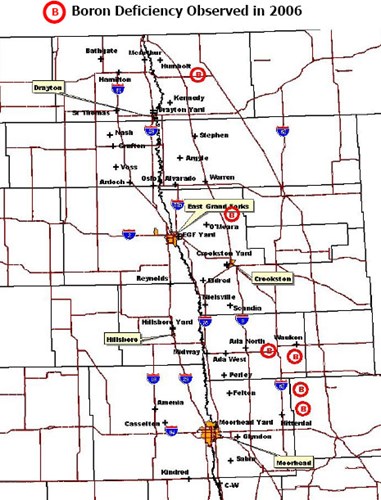493 - Research Results Point the Way
The Sugarbeet Research and Education Board of Minnesota and North Dakota have wisely invested growers check off dollars to solve critical problems facing the industry for the last 35 years. Dedicated scientists at NDSU, the University of Minnesota, USDA and other universities have been held accountable for grant dollars received. Each year results of research are analyzed and improved recommendations to increase yield and quality are developed. This Ag Notes is a brief summary of highlights from some of this recent research. More information will be published in the Annual Research and Extension reports that will be available by the end of January. Review these reports for more complete data on results discussed.
Crop Rotations
Considerably more corn and soybeans are now grown in the Red River Valley compared to 10 or 15 years ago. Dr. A. Sims, University of Minnesota is evaluating previous crop effects on sugarbeet yield and quality.
Results
- Beets after corn yielded 5 ton per acre less than after wheat
- Beets after soybean yielded about the same as after wheat
- Late season N availability after soybean reduced recoverable sugar per ton
- Beet yields were the same whether fall tillage was moldboard plowing or a chisel plow
Micronutrients Studies – Sims, Franzen, Overstreet
Micronutrients studies were conducted at three sites in the Red River Valley near Waukon, east of Ada and east of Glyndon in 2007.
Results
- Sodium applications increased yields on lower available K sites east of Ada and Glyndon
- Boron deficiencies were observed east of Ada and in the Waukon area.
Potassium
Fertilization Agriculturists have raised concern about the need for potassium fertilizer on lower organic matter sandy textured soils in the Red River Valley. It’s important to keep in mind that corn and soybeans remove 2 to 3 times more K per acre than wheat or barley. This may lower K soil test levels and increase the chance of sugarbeet response to K fertilizer.
Results
- Dr. Overstreet conducted a K fertilizer trial near Glyndon, MN in 2007. The soil test K level was 46 ppm at the site. Yield data is shown in Table 1 on the following page.
Table 1. Effect of Potassium fertilizer on sugarbeet root yield, sucrose percentage, recoverable sugar production, harvest population and gross $ return.

The Red River Valley map shows the areas where Boron deficiencies were observed in 2006. Areas of sandy soil on the west edge of the RRV may also be prone to some deficiencies.

Soil Test to Know
Never apply any fertilizer nutrient without a soil test showing a need for fertilization. Contact your Agriculturist or university soils specialist for assistance. Over application of Boron can cause toxicity to the crop.
Soil Factors That Increase the Likelihood of Responses to K, Na or Micronutrients
- Low soil test levels Coarse textured soil types
- Low organic matter
- Droughty conditions
- High pH
Allied Industry
American Crystal Sugar Company will not be hosting an Allied Industry meeting this winter.
